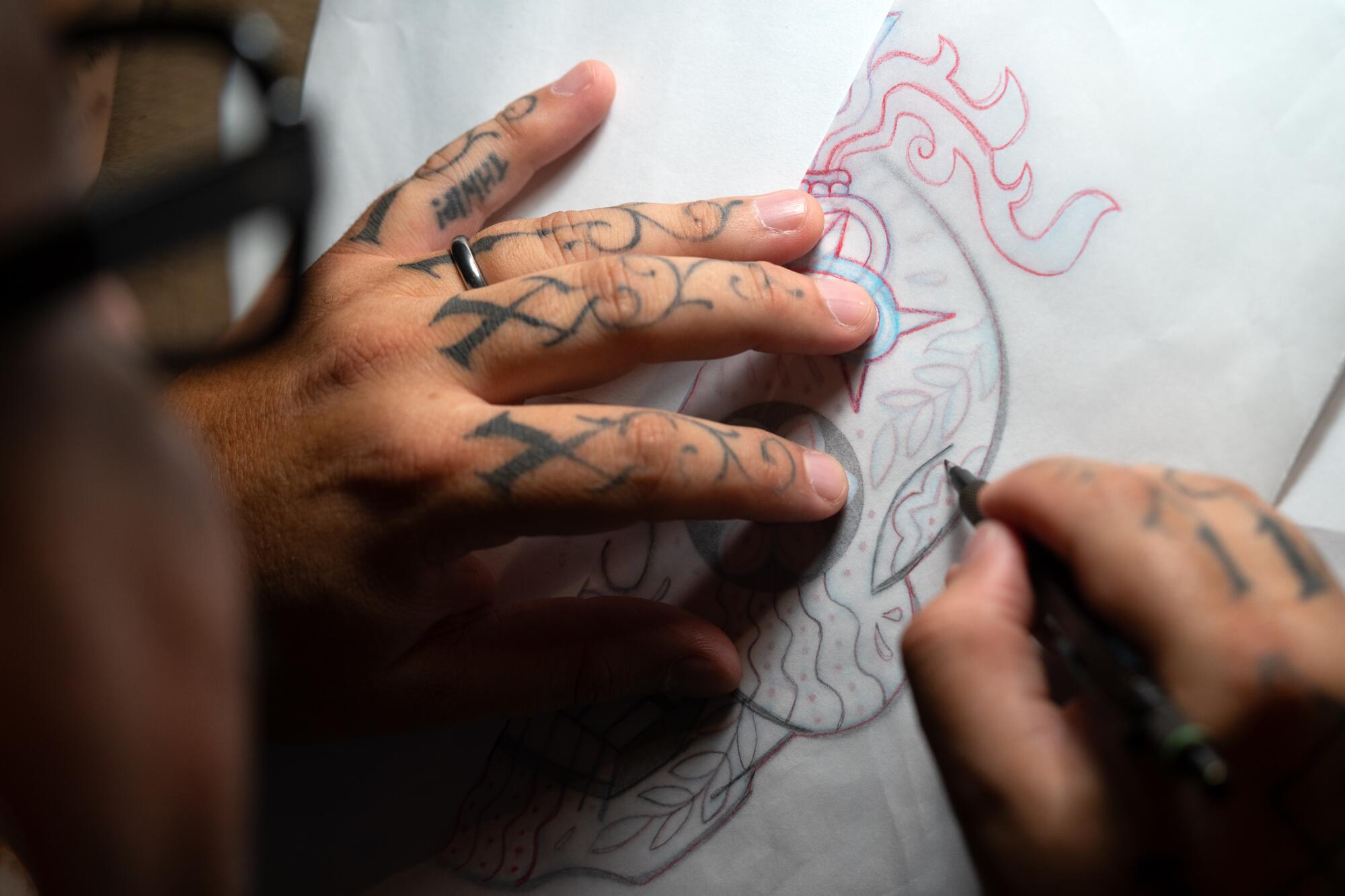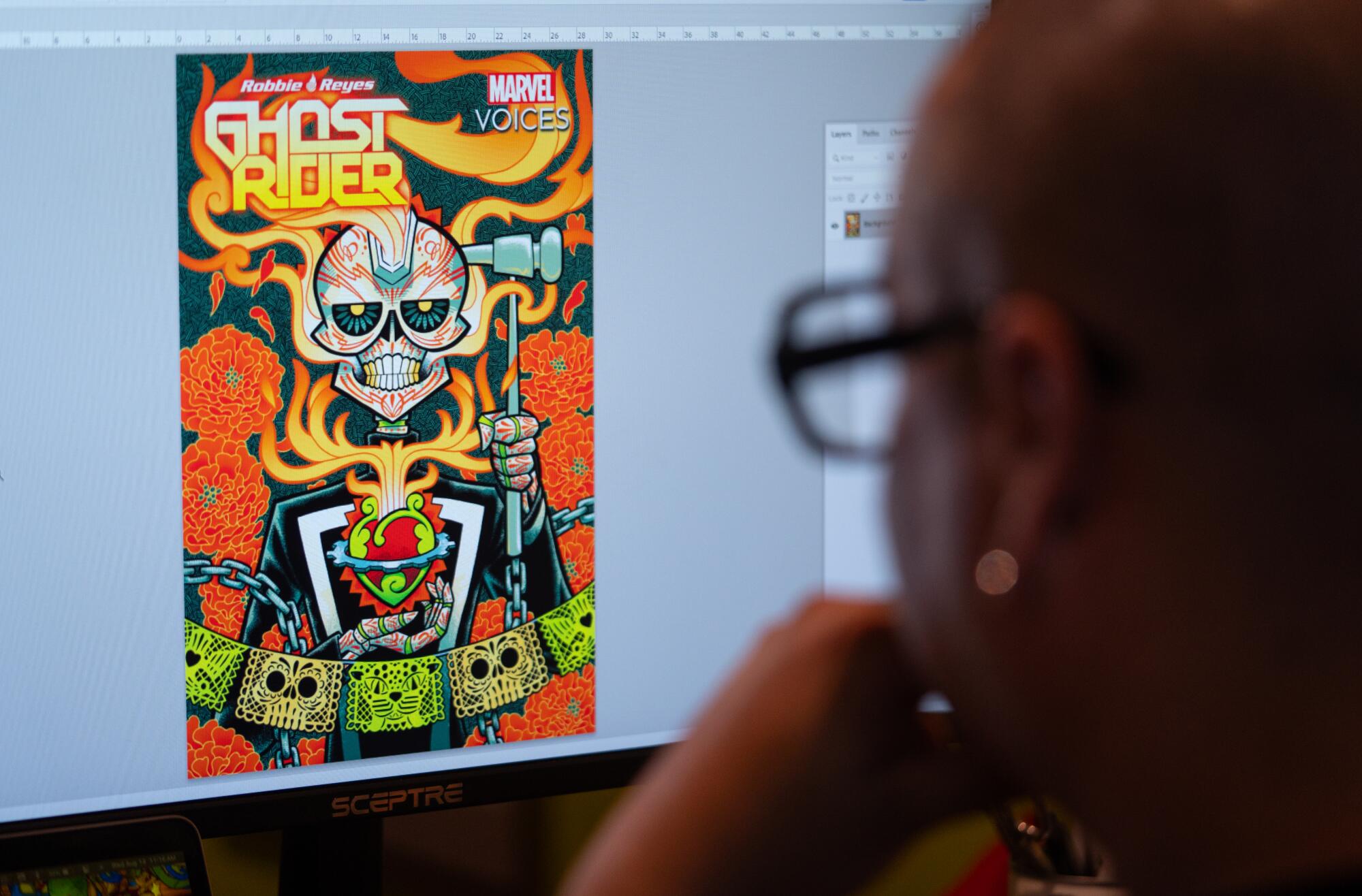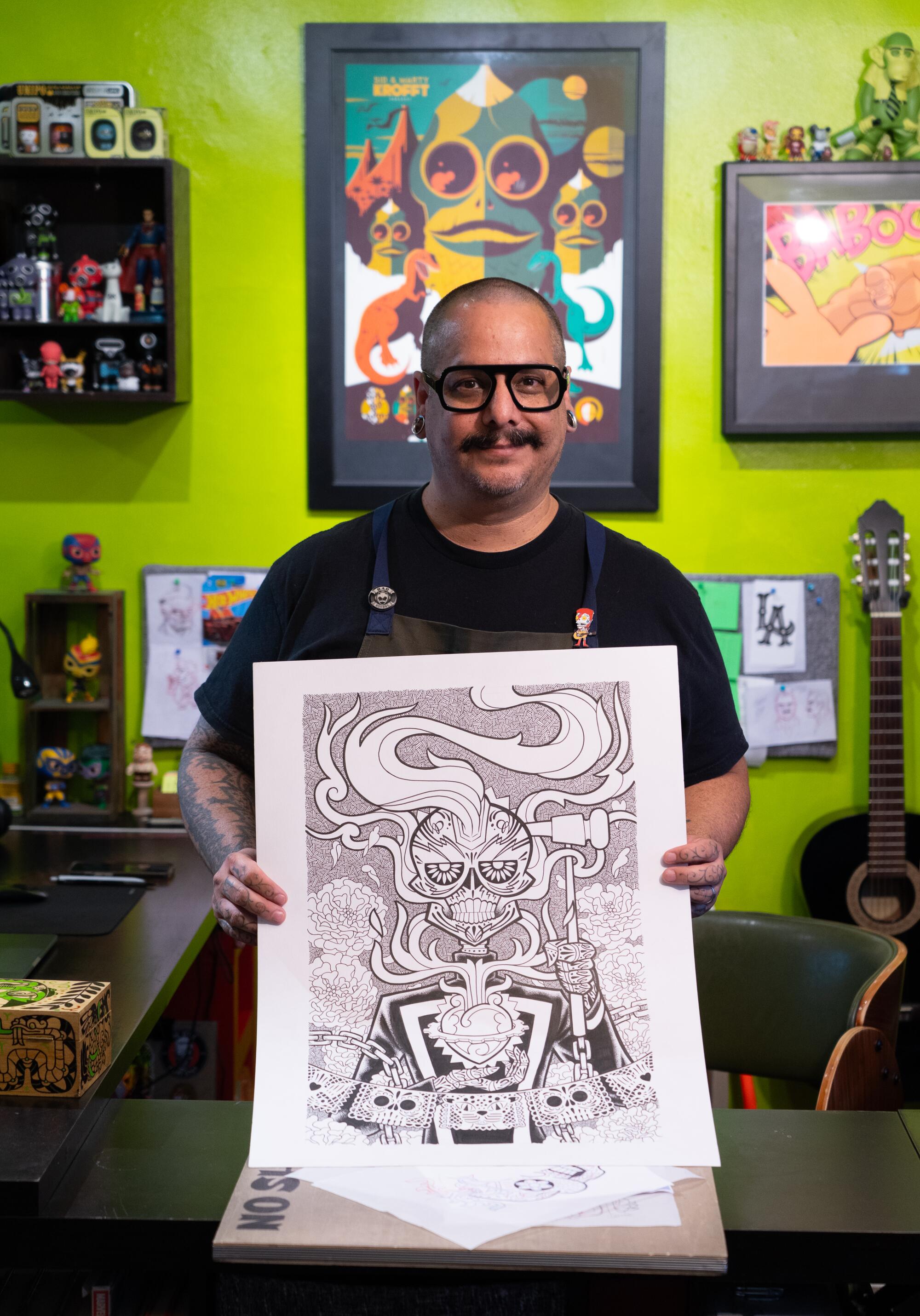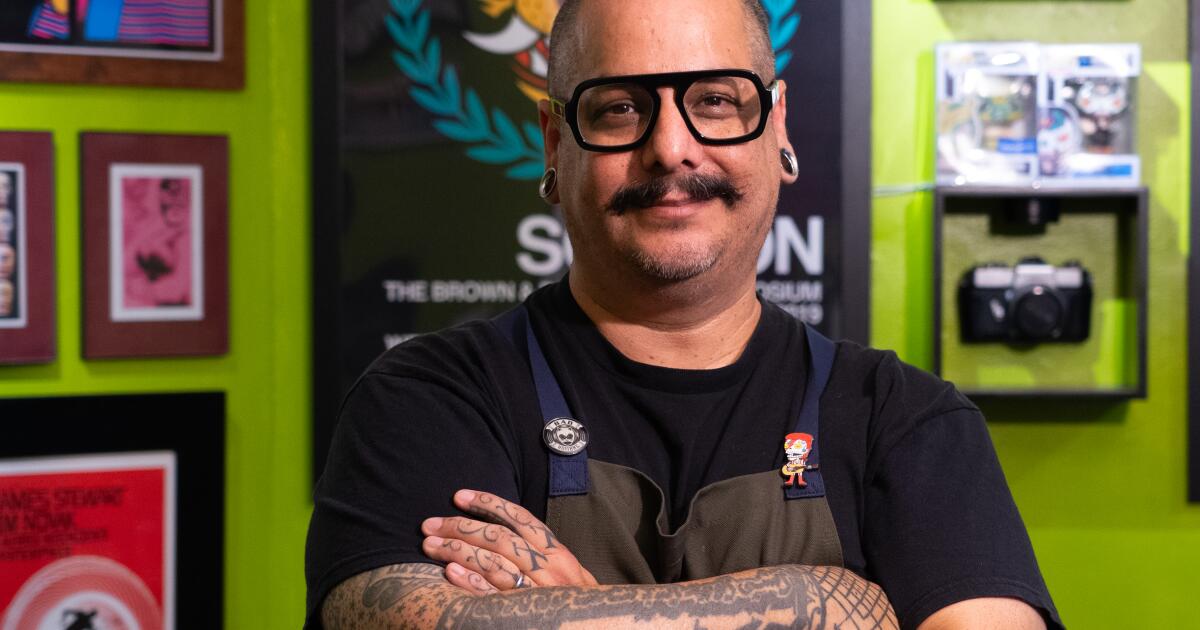Jason Gonzalez, who goes by his artist moniker J. Gonzo, recalls feeling hesitant about accepting a dream gig with Marvel Comics. The company had asked him to create a Día de Muertos-inspired cover for Latino Heritage Month, but before he accepted, he needed to be reassured that his authentic style would be embraced.
The 50-year-old Chicano illustrator with more than a decade of experience as an independent artist had occasionally freelanced for IDW Publishing and Image Comics, but this was his biggest opportunity to date.
“I always feel a moral obligation to not f— this up for other Chicanos,” Gonzo said. “If I do the money grab thing and it doesn’t work, then it’s just an excuse for these companies to never want to do it again.”
Comic book artist J. Gonzo looks at the cover of the Marvel Comics “Ghost Rider” story at his studio in Phoenix on Aug. 14.
(David Wallace / For De Los)
Gonzo, who grew up in Orange County and now lives in Phoenix, said he felt a strong desire to protect his unique Chicano perspective from being used thoughtlessly. That protectiveness over his art grew from the difficulties he faced when he first tried to explore his passion fully.
He grew up admiring comic strips such as “Spider-Man,” which his grandfather regularly clipped for him. As a teenager, he attempted to chase his creative aspirations but was dissuaded by teachers, who shunned his favorite art form as they didn’t see its value as a profession.
After receiving a degree in graphic design from a trade school, Gonzo had a quick stint as a tattoo artist before spending two decades in advertising, eventually working for multiple companies owned by famed comic artist Todd McFarlane.
“I was doing graphic design and a tiny bit of illustration for Todd’s advertising and comic books,” he said. “I would do everything in the comic that wasn’t the comic book.”
Throughout his corporate tenure, Gonzo continued to look for opportunities to work in comic books, but he found it tough to break into the industry. In between his searches, he drew famous superheroes with a Chicano twist and added to his portfolio — lamenting the fact that thist seemed like “a halfway point” as it was an anglicized version of his culture.
Then, during the 2008 recession, he was fired.
“When I was out there looking for work, I had sample pages,” Gonzo said. “Amongst my things was this lucha libre Spawn and I’m like, ‘I should really lean into my culture with this.’”
It led to the creation of his passion project: the 2011 lucha libre tale “La Mano del Destino,” or “The Hand of Destiny.”
His renderings shine with bright hues of yellow, green and pink reminiscent of papel picado — the polar opposite of the classic saturated dark colors used to illustrate famous superheroes.
The series follows Ernesto, a former champion luchador betrayed by friends and unmasked in the ring after refusing to take bribes. He returns to the ring under the Mano del Destino persona in order to seek vengeance and rid lucha libre of corruption. Throughout the six-part series we learn about Ernesto’s past, his deal with a shady promoter before his return and his unknowingly deep connection to the evil he is fighting against.
“Heroism just looks different in Mexico than it does in American people,” Gonzo said. “Western culture heroes tend to succeed because of who they are. I like the kind of definition by result more than by identity.”
To promote his work, he traveled across the country to local comic book conventions. His story was well received by his target audience.

Comic book artist J. Gonzo sketches at his Phoenix studio.
(David Wallace / For De Los)
“Latinos will just walk by and then they would just see the color palette of my booth and they stop in their tracks,” Gonzo said. “Like they had been walking in this world that had nothing for them for so long and suddenly they found the thing for them.”
Gonzo’s growing fan base is part of a larger ongoing trend of Latino creators using the internet to promote their work, said Javier Hernandez, co-founder of the Latino Comics Expo and creator of 1998’s. “El Muerto: Aztec Zombie.”.
“The good thing about our modern time we’re living in is a lot of the gatekeeping has collapsed,” Hernandez said. “Of course you’re competing for millions of viewers with thousands of other creators, but it’s no longer, ‘You have to go with Marvel or DC [Entertainment].’ It’s like the sky is completely open.”
Hernandez says that independent Latino storytellers who work with larger institutions can benefit mutually from the move.
In 2023, the crimefighting turtle brand “Teenage Mutant Ninja Turtles” asked Gonzo to create a cover for a Halloween-themed story. He had worked with IDW Publishing in the past for other illustrations, creating more traditional work with his usual bright color scheme. He decided to submit two designs.
The first one closely followed traditional comic aesthetics and the second was a Day of the Dead-inspired cover that fully represented his vision. After presenting the second version, he was shocked by the brand’s excitement for it. He promptly turned the four Ninja brothers into skeleton turtles, ornately decorated with complex green stripes and color-coordinated marigolds.
When Gonzo received the call from Marvel Comics, he said its representative loved his design for the turtles and wanted to tap into his style for the East L.A. version of Ghost Rider.
Gonzo is one of three cover artists for the recently released Marvel Comics story “Ghost Rider: Robbie Reyes Special #1” highlighting Latino storytellers during Hispanic Heritage Month. Yet for Gonzo, it was more than a single cover. The latest work validates his lifelong goal of authentically depicting his Mexican heritage for comic book fans without catering to a wider audience.

J. Gonzo looks at the comic book artwork for a “Ghost Rider” story he created for Marvel Comics.
(David Wallace / For De Los)
Gonzo’s cover depicts the Latino hero in a flat 2-D drawing resembling Aztec art, he said, instead of the usual 3D action shot. He added lowrider pinstripes, bright orange marigolds and papel picado in the foreground. After submitting the final piece, he expected feedback.
“They didn’t ask me to move a single line or change a single color,” he said. “For them to not even ask me to adjust the shade of anything was tremendously validating.”
“J. Gonzo was able to distill from Robbie Reyes’ Ghost Rider and reconstruct it in a single cover image. It captures the depth of rootedness and cultural ancestry, tradition and mythology,” said Frederick Luis Aldama, a professor at the University of Texas who has written extensively about Latinos in comics. The educator, better known online as Professor LatinX, added that Gonzo is one of the best illustrators in the business.

J. Gonzo holds up a black-and-white version of his cover for “Ghost Rider,” part of Marvel Comics’ Hispanic Heritage Month campaign.
(David Wallace / For De Los)
Whether this art piece leads to more projects with media giants on his terms is yet to be seen, although Gonzo teased that he’s in talks with other companies.
For now, he plans to finish the first issue of his second “La Mano del Destino” series by the end of the year, which he joked was long overdue.
“I’m real over anything kind of dour and greedy,” Gonzo said. “I guarantee, whatever I’m working on, it’s going to have bright vibrant colors and it’s going to have my Chicano thumbprints all over.”

